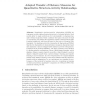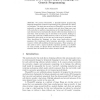ANTSW
2010
Springer
14 years 1 months ago
2010
Springer
Activator-inhibitor models have been widely used to explain several morphogenetic processes. They have also been used to engineer algorithms for computer graphics, distributed syst...
DIS
2010
Springer
14 years 1 months ago
2010
Springer
Quantitative structure-activity relationships (QSARs) are regression models relating chemical structure to biological activity. Such models allow to make predictions for toxicologi...
BMCBI
2008
14 years 3 months ago
2008
Chemical named entities represent an important facet of biomedical text. We have developed a system to use character-based ngrams, Maximum Entropy Markov Models and rescoring to r...
AAMAS
2007
Springer
14 years 3 months ago
2007
Springer
Multiagent control provides strategies for aggregating microscopic robots (“nanorobots”) in fluid environments relevant for medical applications. Unlike larger robots, viscou...
HIS
2007
14 years 4 months ago
2007
Chemical information processing posseses a variety of valuable properties, such as, robustness, concurrency, faulttolerance, and evolvability. However, it is difficult to predict...
EUROGP
2008
Springer
14 years 4 months ago
2008
Springer
We present PlasmidPL, a plasmid-inspired programming language designed for Genetic Programming (GP), and based on a chemical metaphor. The basic data structures in PlasmidPL are ci...
CIKM
2008
Springer
14 years 5 months ago
2008
Springer
Based on the important progresses made in information retrieval (IR) in terms of theoretical models and evaluations, more and more attention has recently been paid to the research...
JCDL
2010
ACM
14 years 8 months ago
2010
ACM
In recent years, the vast amount of digitally available content has lead to the creation of many topic-centered digital libraries. Also in the domain of chemistry more and more di...
SAC
2010
ACM
14 years 8 months ago
2010
ACM
This paper aims at pushing the clear relationship between software service composition and chemical dynamics a step forward. We developed a coordination model where services and c...





